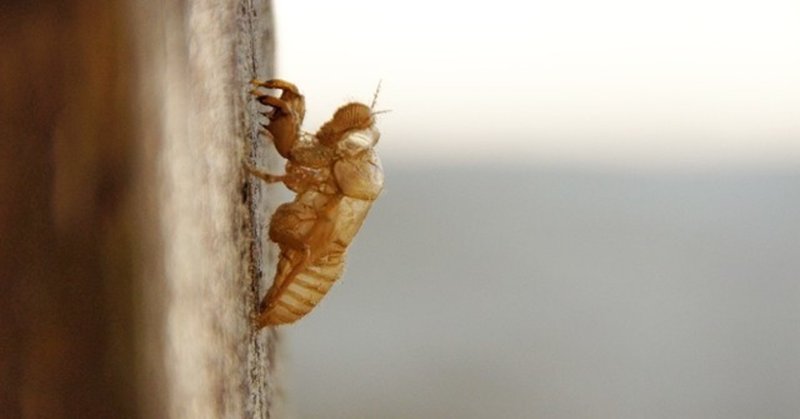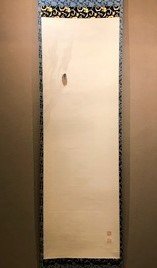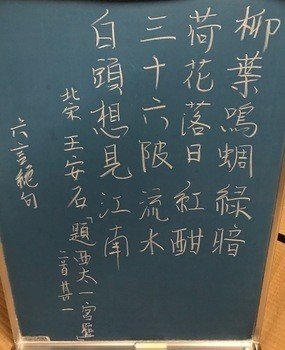
王安石の心情と、蝉一匹のお軸の関係性。 The relationship between Wang's feelings and the axis of one cicada.
昨日の記事では、カワセミが一羽。今日の内容は蝉が一匹。ともに「一」が続いた。
In yesterday's article, there was one kingfisher. Today's content is one cicada. Both were "one".
見てのとおりお軸(写真)は、一匹の蝉だけが描かれている。賛(文)も無ければ、なにも無い。蝉を描いた人の落款の朱があるのみ。これを描いた人の境地は計り知れない。
As you can see (photo), the axis has only one cicada. If there is no word (sentence), there is nothing. There is only the vermilion mark of the person who painted the cicada. The person who drew this picture is immeasurable.

漢詩的には、蝉は初夏から秋にかけよく登場する題材の一つである。中国では秋蝉(しゅうせん)といわれ、騒がしい比喩に例えられ、また地中から出てきたセミは復活の象徴とされている。玉(ぎょく/ たま/ヒスイ)などにセミの姿を彫り、復活の装飾品とされている。
In Chinese poetry, cicadas are one of the subjects that often appear from early summer to autumn. In China, it is called the autumn cicada, and it is compared to the noisy metaphor, and the cicada that emerges from the ground is a symbol of the resurrection. A cicada is carved on a ball (gyoku/tama/jade) etc., and it is said to be a revival accessory.
煎茶サロンのお題は、北宋の政治家であり文人として名を馳せた王安石の「題西太一宮壁」という詩を、蝉一匹のお軸を前に教えていただいた。漢詩としては珍しい六言絶句である。
The subject of the Sencha Salon was a poem called "題西太一宮壁 " by Wang Anseki, a politician and famous literary in the Northern Song Dynasty, who taught me the axis of one cicada. It is a six-word phrase that is rare in Chinese poetry.
柳葉鳴蜩綠暗,
荷花落日紅酣。
三十六陂流水,
白頭想見江南。
非常に高いレベルの詩のようだが、われわれにはその凄さは読みとれない。
が、教えていただいたことを一節ごとに訳してみると、
It sounds like a very high level poem, but we can't read it.
But, when I try to translate what you have taught,

柳葉鳴蜩緑暗
柳の樹でセミが鳴き、柳の葉が色濃く繁り暗くなっている。つまり、騒がしい批判の声があがっており、鬱陶しい。
Cicadas squeal in the willow tree, and the leaves of the willow are deep and dark. In other words, there are loud criticisms and annoyances.
荷花落日紅酣
蓮の花は、沈もうとする太陽に花が紅に染まっている。今は絶頂期であるものの、やがて衰頽期を迎える。
The lotus flowers are dyed red in the setting sun. Although it is at its peak now, it will soon come to a decline.
三十六陂流水
三十六の湖沼が四方八方に広がって流れている。
Thirty-six lakes spread in all directions.
白頭想見江南
これを見ると故郷の江南を思い浮かべ故郷を聯想(れんそう)する。そこで隠棲したいものだと想いを馳せる。
When I see this, I think of my hometown of Gangnam and think of my hometown. There, I feel that I want to hide.
ということになる。
It turns out that.
蝉を引用しながら、柳の草色、太陽の赤、流水の水色(茶色?)、そして白髪の白など、文字で色合わせを楽しんでいる。人生の終焉には、故郷を偲ぶのは人の常なのかもしれない。
While quoting cicadas, he enjoys matching colors with the characters, such as the willow color of the willow, the red of the sun, the light blue of running water (brown?), and the white of gray hair. At the end of life, people may always remember their hometown.
この詩と、お軸は「蝉」でつながっているが、この詩を解いていく際に、王安石は文字で色を表現し自分の人生の終焉を想像したといわれている。では、この蝉一匹のお軸を掲げた計らいは、観た人がこの広い空白に自分の色を染めてみては、という提案なのかもしれない。
This poem is connected to the axis by a "cicada," but it is said that when he solved this poem, Wang Anseki expressed the color with letters and imagined the end of his life. Then, the measure with the axis of this cicada may be a suggestion that the viewer should try to dye your color in this wide space.
レポート & 写真 / 渡邉雄二 お軸 / 一茶庵
Reported & Photos by Yuji Watanabe
Axis / Issaan
よろしければサポートお願いします。日本の伝統文化に関心を寄せています。若いころに文化圏の異なる地域の方たちとの交流で日本のことをあまりにも知らなかったことに気づかされ、それがきっかけで広く浅く学んでいます。拙いレポートですが、お目に留めていただければ幸です。
